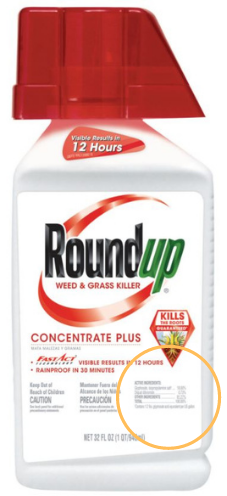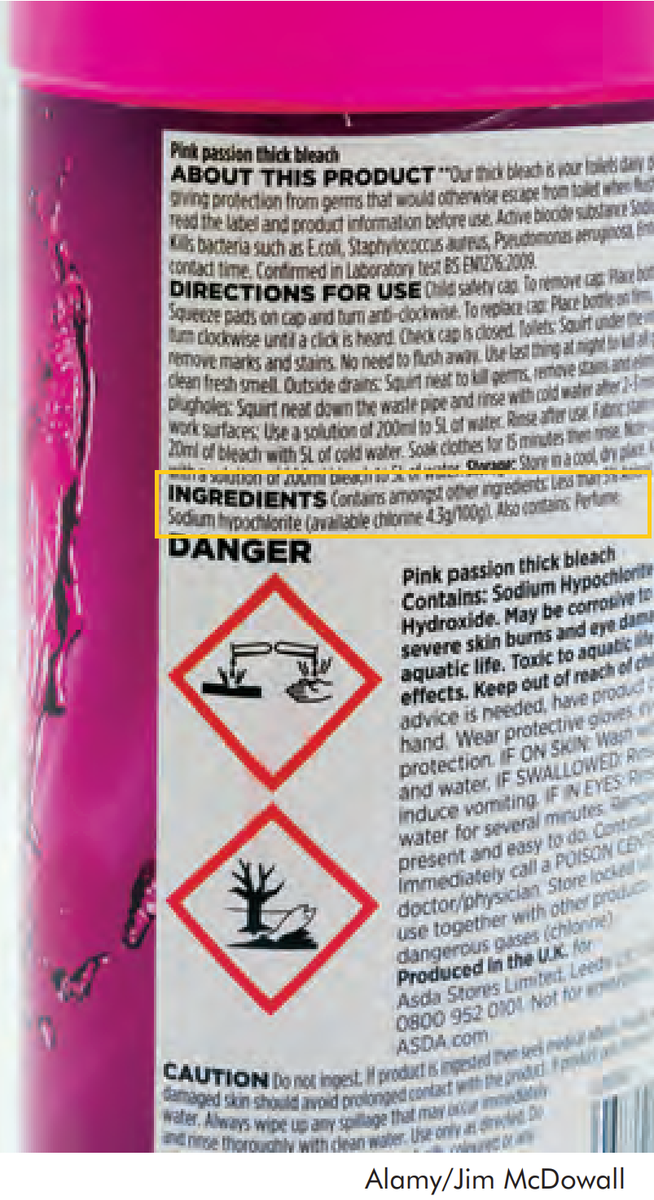Gateway on Pesticide Hazards and Safe Pest Management
How To Find Ingredients in Pesticide Products
Beyond Pesticides offers resources below to evaluate the health and ecological effects of specific chemical exposure from ACTIVE INGREDIENTS in pesticide products, as well as regulatory information and supporting scientific documents. Because various pesticide products can contain more than one active ingredient, it is important to READ the LABEL to determine chemical components.
With 192 different active ingredients and counting, it is essential to establish the connection between the use of these chemicals and their respective hazards.
View the step-by-step guide on how to search for the active ingredient(s) in pesticide products below:
- Go to U.S. EPA's Pesticide Product and Label System and enter the product name. The generic product name may vary.
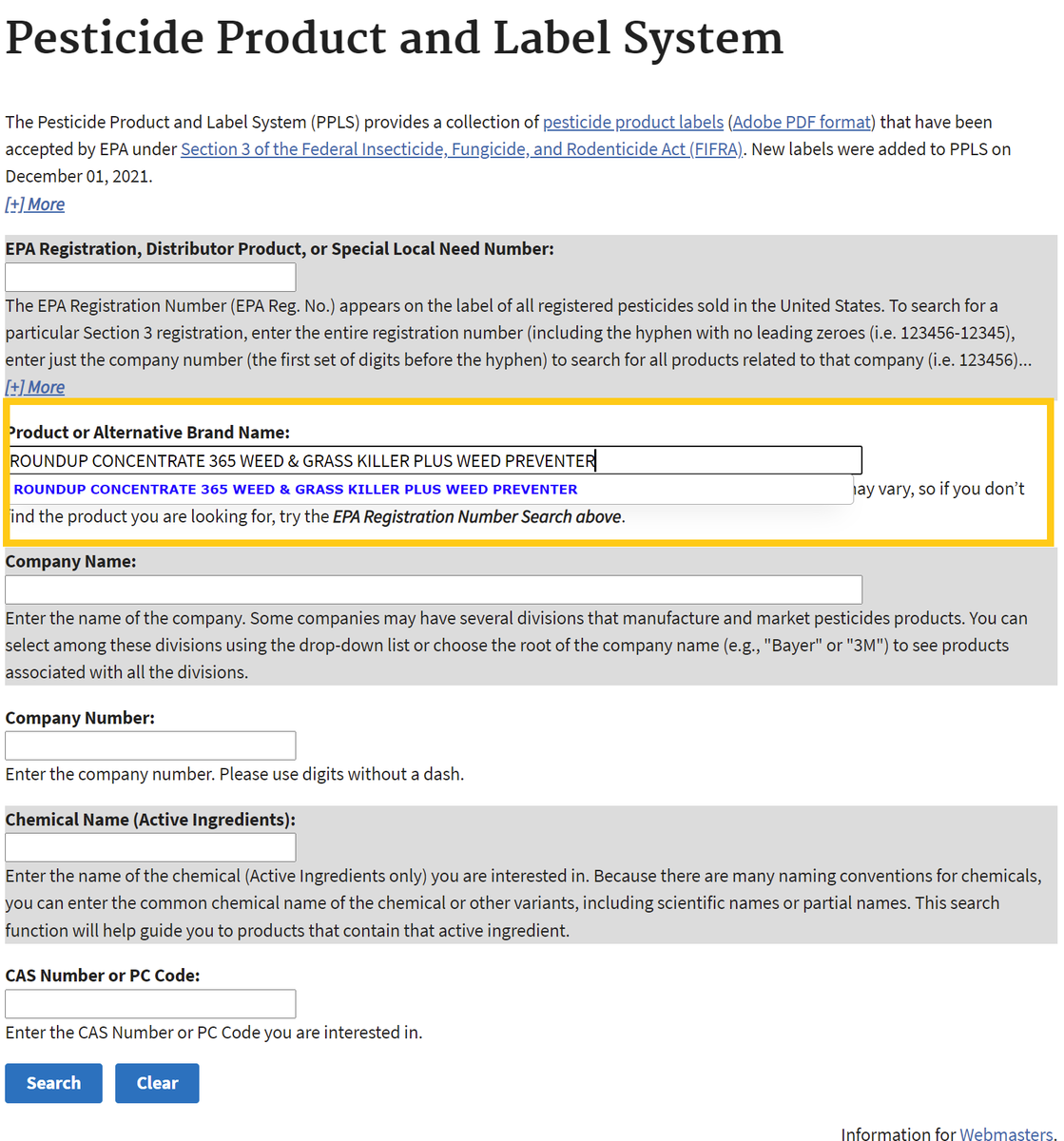
- After searching, click on the chemical ingredients tab or the link for the most recent label to find Active Ingredients.
Chemical List Label List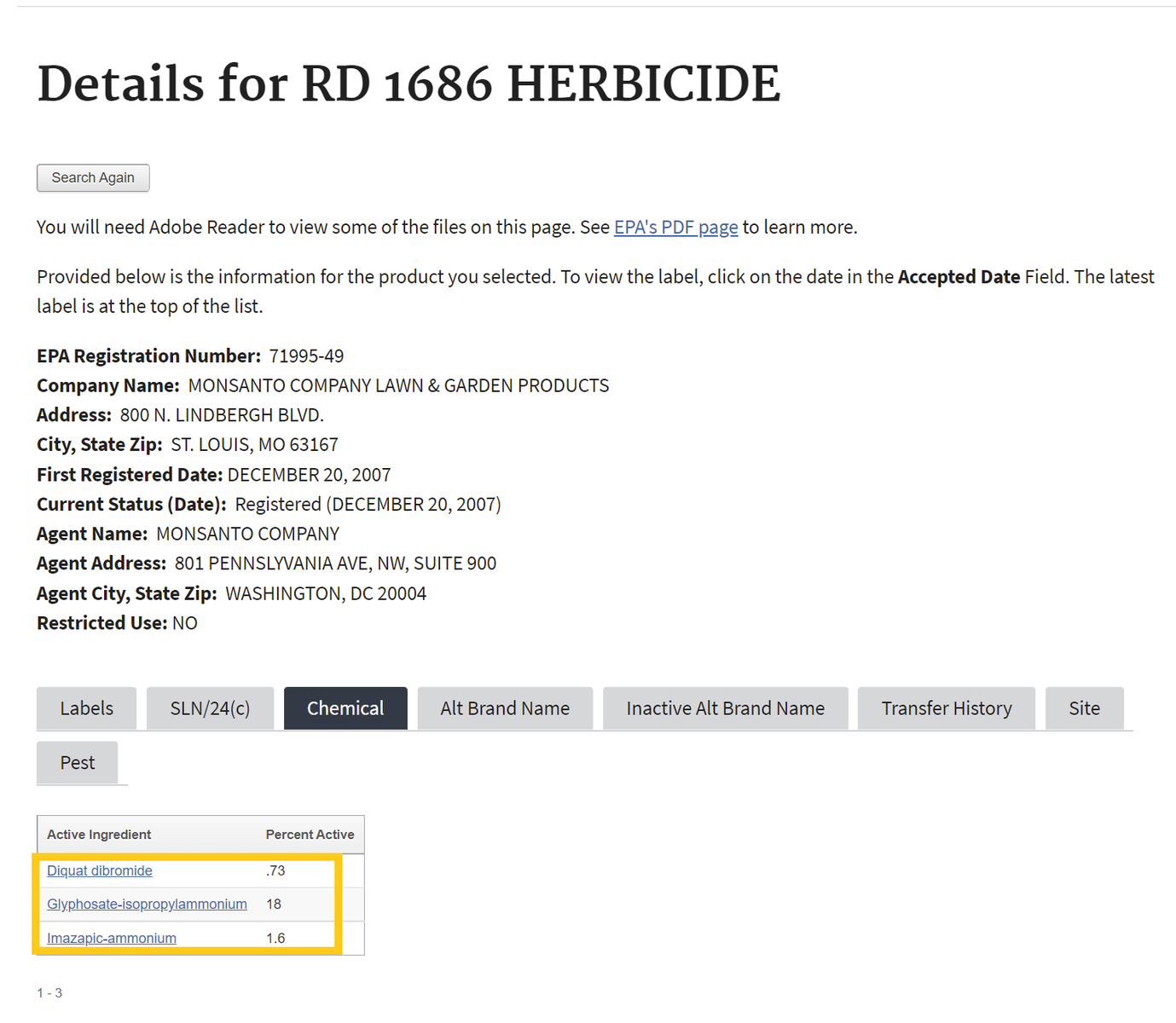
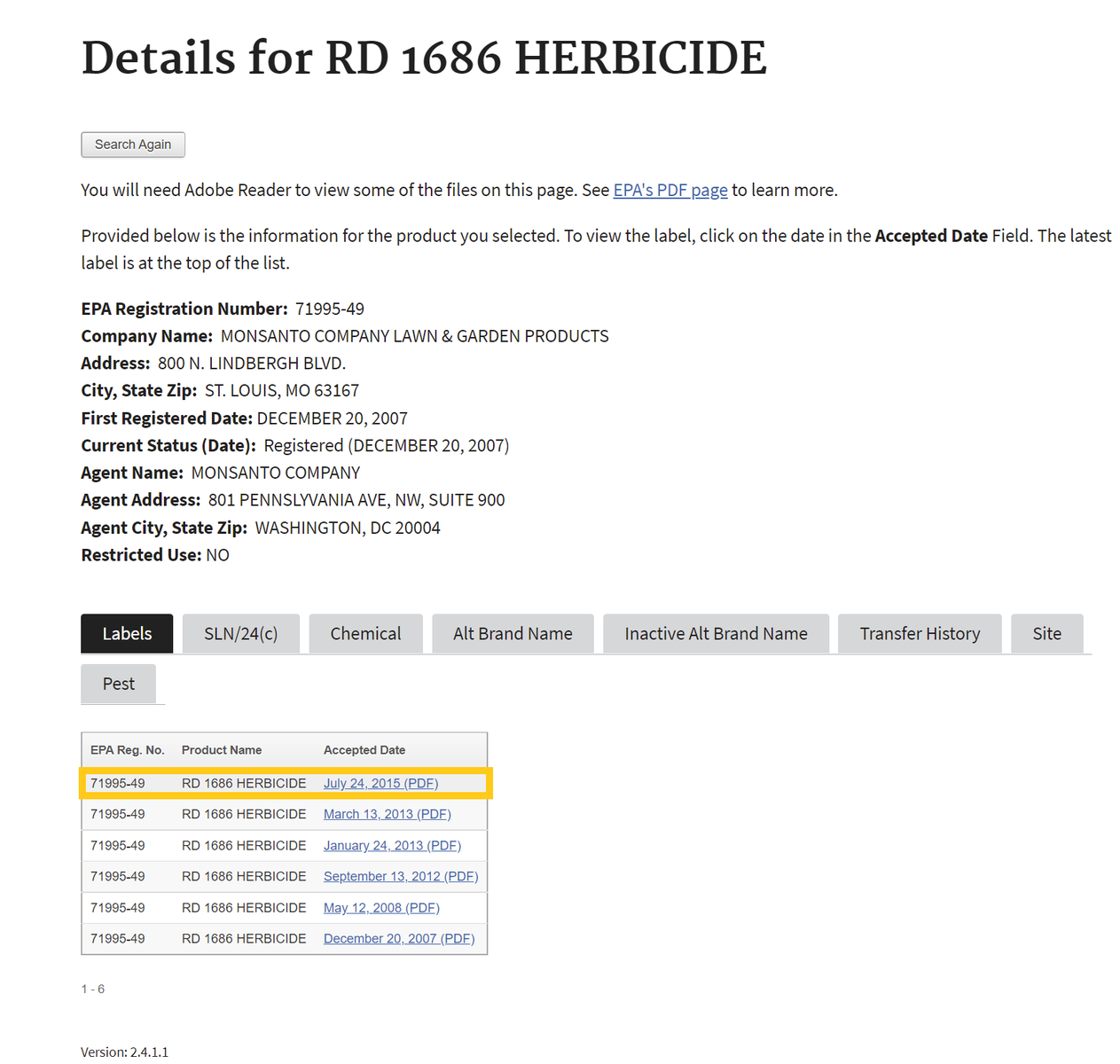
If one selects the chemical ingredients tab, skip to Step 4 . If not, proceed to step number 3 - To find the active ingredient(s) on the label, search for the page in the document containing the date of registration. Usually, the active ingredients section occurs within the first few pages of the label document.
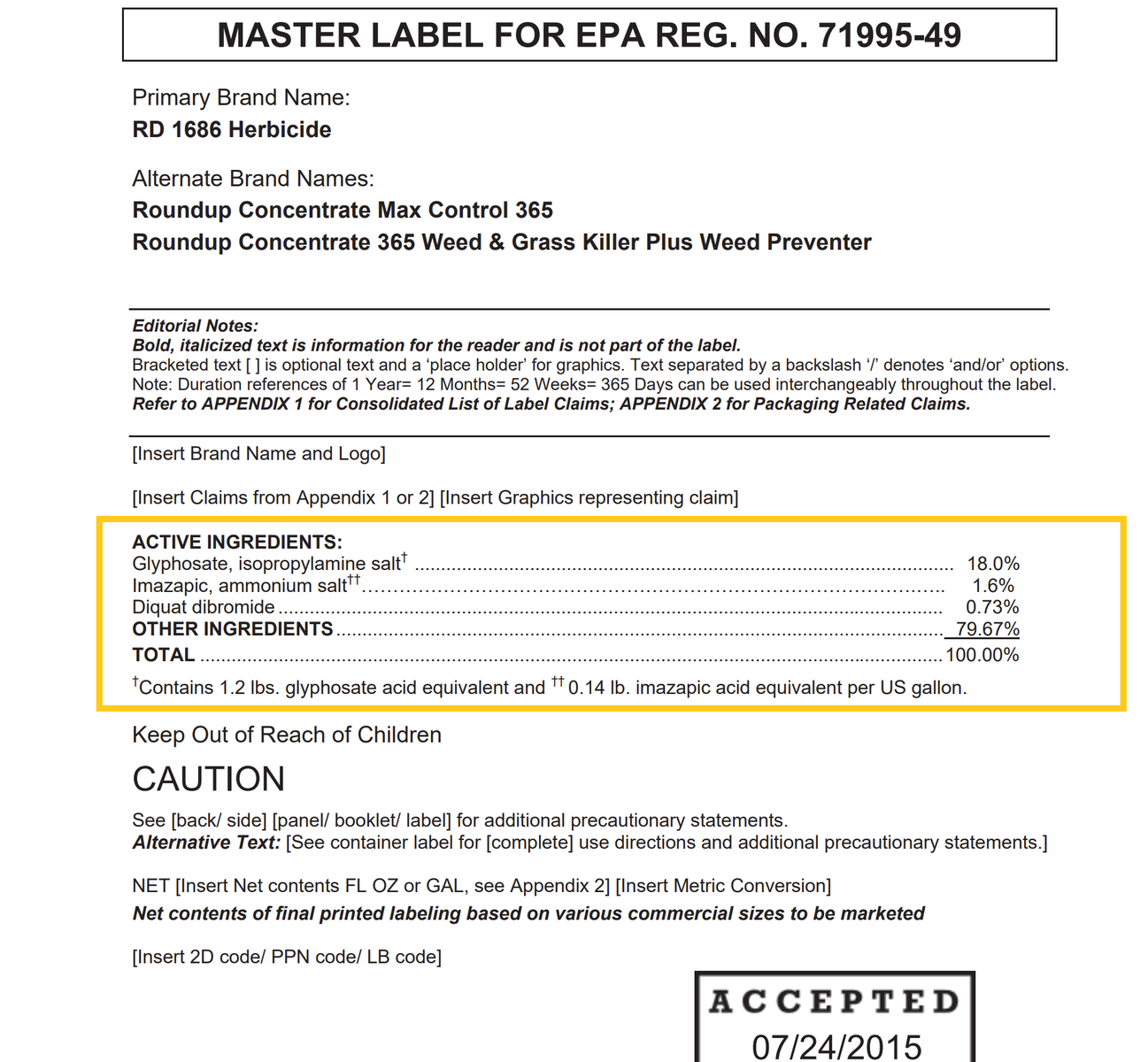
- Return to the Beyond Pesticides Gateway and search for the active ingredient name in the yellow box to the right or from the list below.
Sulfoxaflor
General Information
- Product Names:
- Chemical Class: Systemic sulfoximine insecticide, although some classify it as a neonicotinoid insecticide
- Uses: Restricted applications for post-bloom only for crops that are attractive to bees: Barley, triticale, wheat, turf grass; are harvested before bloom: Brassica leafy vegetables, Bulb vegetables, Leafy vegetables (non-Brassica) and watercress, Leaves of root and tuber vegetables, Root and tuber vegetables; and post-bloom applications for bee attractive crops: Berries (grape, blueberry, cranberry),Canola,Fruiting vegetables (tomato, pepper, eggplant) and okra, Pome fruit, Ornamentals, Potato, Stone fruit, Succulent and dry beans, Tree nuts and pistachio.
- Beyond Pesticides rating: Toxic
Health and Environmental Effects
- Cancer: Suggestive evidence (8)
- Endocrine Disruption: Not documented
- Reproductive Effects: Not documented
- Neurotoxicity: Not documented
- Kidney/Liver Damage: Not documented
- Sensitizer/ Irritant: Not documented
- Birth/Developmental: Not documented
- Detected in Groundwater: Not documented
- Potential Leacher: Not documented
- Toxic to Birds: Not documented
- Toxic to Fish/Aquatic Organisms: Not documented
- Toxic to Bees: Yes (8)
Additional Information
- Regulatory Status:
- Supporting information:
- Studies:
- Bees under interactive stressors: the novel insecticides flupyradifurone and sulfoxaflor along with the fungicide azoxystrobin disrupt the gut microbiota of honey bees and increase opportunistic bacterial pathogens. Al Naggar, Y., Singavarapu, B., Paxton, R.J. and Wubet, T., 2022. Science of The Total Environment, 849, p.157941.
- Toxic temperatures: Bee behaviors exhibit divergent pesticide toxicity relationships with warming.. Kenna, D., Graystock, P. and Gill, R.J., 2023..Global Change Biology.
- Characterization of Sulfoxaflor and Its Metabolites on Survival, Growth, Reproduction, Biochemical Markers, and Transcription of Genes of Daphnia magna. Yuan, T., Jiao, H., Ai, L., Chen, Y., Hu, D. and Lu, P., 2023. Journal of Agricultural and Food Chemistry, 71(16), pp.6424-6433.
- Field-realistic exposure to neonicotinoid and sulfoximine insecticides impairs visual and olfactory learning and memory in Polistes paper wasps. Fiona E. Corcoran, Elizabeth A. Tibbetts; Field-realistic exposure to neonicotinoid and sulfoximine insecticides impairs visual and olfactory learning and memory in Polistes paper wasps. J Exp Biol 15 November 2023; 226 (22): jeb246083. doi: https://doi.org/10.1242/jeb.246083
- Chronic exposure to insecticides impairs honeybee optomotor behaviour. Parkinson, R., Fecher, C. and Gray, J. (2022) Chronic exposure to insecticides impairs honeybee optomotor behaviour, Frontiers in Insect Science. Available at: https://www.frontiersin.org/journals/insect-science/articles/10.3389/finsc.2022.936826/full.
- Assessment of acute and chronic toxicity of cyantraniliprole and sulfoxaflor on honey bee (Apis mellifera) larvae. Kim, J., Chon, K., Kim, B. S., Oh, J. A., Yoon, C. Y., & Park, H. H. (2022). Assessment of acute and chronic toxicity of cyantraniliprole and sulfoxaflor on honey bee (Apis mellifera) larvae. Pest management science, 78(12), 5402–5412. https://doi.org/10.1002/ps.7162
- Romance in peril: A common pesticide impairs mating behaviours and male fertility of solitary bees (Osmia bicornis). Vélez-Trujillo, L. et al. (2025) Romance in peril: A common pesticide impairs mating behaviours and male fertility of solitary bees (Osmia bicornis), Chemosphere. Available at: https://www.sciencedirect.com/science/article/pii/S0045653525002772.
- Effects of chronic exposure to the new insecticide sulfoxaflor in combination with a SDHI fungicide in a solitary bee. Azpiazu, Celeste & Bosch, Jordi & Martins, Cátia & Sgolastra, Fabio. (2022). Effects of the Chronic Exposure to the New Insecticide Sulfoxaflor in Combination with an Sdhi Fungicide in a Solitary Bee. SSRN Electronic Journal. 10.2139/ssrn.4066170.
- Do novel insecticides pose a threat to beneficial insects?. Siviter Harry and Muth Felicity 2020 Do novel insecticides pose a threat to beneficial insects?Proc. R. Soc. B.28720201265 http://doi.org/10.1098/rspb.2020.1265
- Survival rate and changes in foraging performances of solitary bees exposed to a novel insecticide. Boff, S., Scheiner, R., Raizer, J., & Lupi, D. (2021). Survival rate and changes in foraging performances of solitary bees exposed to a novel insecticide. Ecotoxicology and environmental safety, 211, 111869. https://doi.org/10.1016/j.ecoenv.2020.111869
- Comparing the Acute Toxicity of Imidacloprid with Alternative Systemic Insecticides in the Aquatic Insect Chironomus dilutus. Erin M. Maloney, Hunter Sykes, Christy Morrissey, Kerry M. Peru, John V. Headley, Karsten Liber, Comparing the Acute Toxicity of Imidacloprid with Alternative Systemic Insecticides in the Aquatic Insect Chironomus dilutus, Environmental Toxicology and Chemistry, Volume 39, Issue 3, 1 March 2020, Pages 587–594, https://doi.org/10.1002/etc.4639
- The neonicotinoid alternative sulfoxaflor causes chronic toxicity and impairs mitochondrial energy production in Chironomus kiinensis. Liu, Peipei & Wu, Fan & Li, Hui-Zhen & You, Jing. (2021). The neonicotinoid alternative sulfoxaflor causes chronic toxicity and impairs mitochondrial energy production in Chironomus kiinensis. Aquatic Toxicology. 235. 105822. 10.1016/j.aquatox.2021.105822.
- Toxicity of the insecticide sulfoxaflor alone and in combination with the fungicide fluxapyroxad in three bee species. Azpiazu, C., Bosch, J., Bortolotti, L. et al. Toxicity of the insecticide sulfoxaflor alone and in combination with the fungicide fluxapyroxad in three bee species. Sci Rep 11, 6821 (2021). https://doi.org/10.1038/s41598-021-86036-1
- The sulfoximine insecticide sulfoxaflor exposure reduces the survival status and disrupts the intestinal metabolism of the honeybee Apis mellifera. Cheng, S., Dai, P., Li, R., Chen, Z., Liang, P., Xie, X., Zhen, C., & Gao, X. (2023). The sulfoximine insecticide sulfoxaflor exposure reduces the survival status and disrupts the intestinal metabolism of the honeybee Apis mellifera. Journal of hazardous materials, 442, 130109. https://doi.org/10.1016/j.jhazmat.2022.130109
- Sulfoxaflor exposure reduces bumblebee reproductive success. Siviter, H., Brown, M.J.F. & Leadbeater, E. Sulfoxaflor exposure reduces bumblebee reproductive success. Nature 561, 109–112 (2018). https://doi.org/10.1038/s41586-018-0430-6
- Fungicide and insecticide exposure adversely impacts bumblebees and pollination services under semi-field conditions. Tamburini, G., Pereira-Peixoto, M. H., Borth, J., Lotz, S., Wintermantel, D., Allan, M. J., Dean, R., Schwarz, J. M., Knauer, A., Albrecht, M., & Klein, A. M. (2021). Fungicide and insecticide exposure adversely impacts bumblebees and pollination services under semi-field conditions. Environment international, 157, 106813. https://doi.org/10.1016/j.envint.2021.106813
- Sulfoxaflor and nutritional deficiency synergistically reduce survival and fecundity in bumblebees. Linguadoca, A., Rizzi, C., Villa, S., & Brown, M. J. F. (2021). Sulfoxaflor and nutritional deficiency synergistically reduce survival and fecundity in bumblebees. The Science of the total environment, 795, 148680. https://doi.org/10.1016/j.scitotenv.2021.148680
- Field rates of Sivanto™ (flupyradifurone) and Transform® (sulfoxaflor) increase oxidative stress and induce apoptosis in honey bees (Apis mellifera L.). Chakrabarti P, Carlson EA, Lucas HM, Melathopoulos AP, Sagili RR (2020) Field rates of Sivanto™ (flupyradifurone) and Transform® (sulfoxaflor) increase oxidative stress and induce apoptosis in honey bees (Apis mellifera L.). PLOS ONE 15(5): e0233033. https://doi.org/10.1371/journal.pone.0233033
- Sulfoxaflor influences the biochemical and histological changes on honeybees (Apis mellifera L.). Ibrahim, ED.S., Abd Alla, A.E., El-Masarawy, M.S. et al. Sulfoxaflor influences the biochemical and histological changes on honeybees (Apis mellifera L.). Ecotoxicology 32, 674–681 (2023). https://doi.org/10.1007/s10646-023-02677-0
- Toxic temperatures: Bee behaviours exhibit divergent pesticide toxicity relationships with warming. Kenna, D., Graystock, P., & Gill, R. J. (2023). Toxic temperatures: Bee behaviours exhibit divergent pesticide toxicity relationships with warming. Global Change Biology, 29, 2981–2998. https://doi.org/10.1111/gcb.16671
- Urinary pesticide biomarkers from adolescence to young adulthood in an agricultural setting in Ecuador: Study of secondary exposure to pesticides among children, adolescents, and adults (ESPINA) 2016 and 2022 examination data. Parajuli, R. et al. (2025) Urinary pesticide biomarkers from adolescence to young adulthood in an agricultural setting in Ecuador: Study of secondary exposure to pesticides among children, adolescents, and adults (ESPINA) 2016 and 2022 examination data, Data in Brief. Available at: https://www.sciencedirect.com/science/article/pii/S2352340925006067.
- Lethal Toxicity and Sublethal Metabolic Interference Effects of Sulfoxaflor on the Earthworm (Eisenia fetida). Fang, Song et al. “Lethal Toxicity and Sublethal Metabolic Interference Effects of Sulfoxaflor on the Earthworm ( Eisenia fetida).” Journal of agricultural and food chemistry vol. 66,45 (2018): 11902-11908. doi:10.1021/acs.jafc.8b04633
- Bees exposed to climate change are more sensitive to pesticides. Albacete, S., Sancho, G., Azpiazu, C., Rodrigo, A., Molowny-Horas, R., Sgolastra, F., & Bosch, J. (2023). Bees exposed to climate change are more sensitive to pesticides. Global Change Biology, 29, 6248–6260. https://doi.org/10.1111/gcb.16928








.png)
